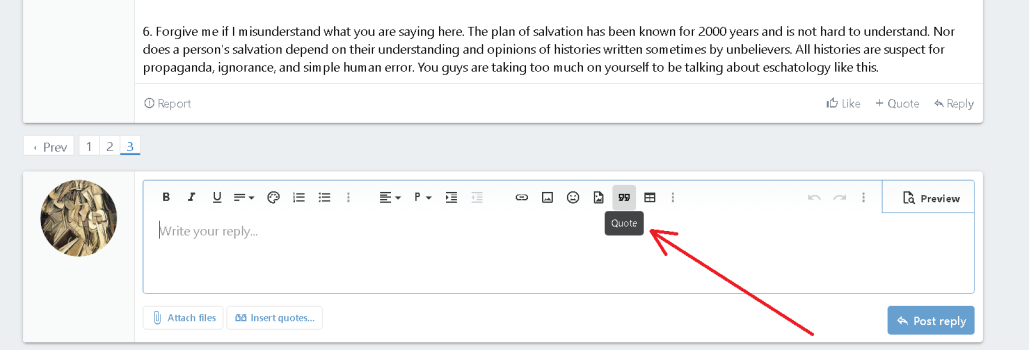Here is from
Wikipedia and it is pretty straightforward:
"One of the most influential aspects of the early
Protestant historicist
paradigm was the assertion that scriptural identifiers of the Antichrist were matched only by the institution of the Papacy. Particular significance and concern were the Papal claims of authority over the Church through Apostolic Succession, and the State through the Divine Right of Kings. When the Papacy aspires to exercise authority beyond its religious realm into civil affairs, on account of the Papal claim to be the Vicar of Christ, then the institution was fulfilling the more perilous biblical indicators of the
Antichrist.
Martin Luther wrote this view into the
Smalcald Articles of 1537; this view was not novel and had been leveled at various popes throughout the centuries, even by Roman Catholic saints.
[2] It was then widely popularized in the 16th century, via sermons, drama, books, and
broadside publication.
[3] The alternate methods of prophetic interpretation,
Futurism and
Preterism were derived from Jesuit writings, whose counter-reformation efforts were aimed at opposing this interpretation
[4][5][6][7] that the Antichrist was the
Papacy or the power of the
Roman Catholic Church.
[8]"
The Protestant Reformers, including John Wycliffe, Martin Luther, John Calvin,, John Knox, Roger Williams, Cotton Mather, Jonathan Edwards, and John Wesley etc.., as well as most Protestants believers, felt that the Early Church of Christ and the Apostles, had been led into the Great Apostasy by the Papacy and identified the Pope with the Antichrist. The Centuriators of Magdeburg, a group of Lutheran scholars in Magdeburg headed by Matthias Flacius, wrote the 12-volume Magdeburg Centuries to discredit the Catholic Church and lead other Christians to recognize the Pope as the Antichrist. So, rather than expecting a single Antichrist to rule the earth during a future Tribulation period, Martin Luther, John Calvin, and other Protestant Reformers saw the Antichrist as a present feature in the world of their time, fulfilled in the Papacy.
Now in order to counter this view that the papacy was the Antichrist power it the church turned to the Jesuits who were summoned to pus back the reformers' teachings, and here two Jesuit scholars stand out in particular. They are Ribera and Alcasar, and they developed the
Futurist and Preterist systems of prophetic interpretation.
Spanish Jesuit Francisco Ribera published a commentary on the book of Revelation which proposed that the bulk of the prophecies would be fulfilled in a brief three-and-one-half-year period at the end of the Christian era. In that short space antichrist (a single individual, according to Ribera) would rebuild the Jerusalem Temple, deny Christ, abolish Christianity, be received by the Jews, pretend to be god, and conquer the world. Thus the Protestant contention that the apocalyptic symbols of antichrist denoted an apostate religious system was countered, and the focus of the prophecies was diverted from the present to the far distant future.
Spanish Jesuit, Luis de Alcazar also published a scholarly work on Revelation, to refute the Protestant Reformation on the Antichrist power. Alcazar's thesis, the opposite of Ribera's, was that all the prophecies of Revelation had been fulfilled in the past, that is, by the fifth and sixth centuries A.D., the early centuries of Christianity. He asserted that this prophetic book simply described a two-fold war by the church-its victory over the Jewish synagogue on the one hand (chaps. 1-11) and Roman paganism on the other (chaps. 12-19). Chapters 21, 22 Alcazar applied to the Roman Catholic Church as the New Jerusalem, glorious and triumphant. His writings were developed into a system of interpretation known as preterism.
Over time these specific systems of counter interpretations of the Antichrist spread and began to penetrate Protestant thought. Preterism was the first; it began to enter Protestantism in the late eighteenth century. Preterist interpretations of the prophecies have today become the standard view of liberal Protestantism.
The ideas of futurism, although refuted at first, eventually spread into Protestantism during the nineteenth century. So the Protestant denominations have picked up these counter reformation views set about to change the views of the papacy as the Antichrist power that was from the Reformers.
The false doctrine of Preterism and Futurism, as you can see, basically are to put aside the Reformers view of the Antichrist which was held by the main body of Protestants. Preterist interpretation puts all prophecy pertaining to the Antichrist into the past so it is long gone, and the Futurist interpretation puts them into the future so the papacy could claim it was not this power. It is a deception which has been picked up and spread through the churches which has become a stumbling block for many people as they are fed its lies by these false doctrines..



